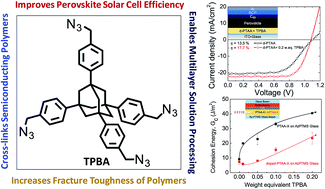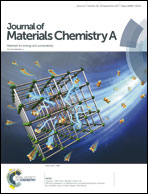Synthesis and use of a hyper-connecting cross-linking agent in the hole-transporting layer of perovskite solar cells†
Abstract
Solution-processed organic semiconducting materials feature prominently in modern optoelectronic devices, especially where low-cost and flexibility are specific goals, such as perovskite solar cells. Their intrinsic solubility, poor cohesion and lack of adhesion to underlying substrates, however, curtail their scope of application and durability. To overcome this, a mechanically stiff, light-activated, tetra-azide cross-linking agent, 1,3,5,7-tetrakis-(p-benzylazide)-adamantane (TPBA), has been developed to transform solution processed organic polymers into solvent-resistant and mechanically tough films. The use of 3-azidopropyltrimethoxysilane (AzPTMS) has been developed as a light-activated adhesion promotor, enabling mechanical testing of toughened, cross-linked polymers. Lithium bis(trifluoromethane)sulfonimide (LiTFSI) doped poly[bis(4-phenyl)(2,4,6-trimethylphenyl)amine, poly(triaryl amine) (PTAA), a hole-transporting material used in perovskite solar cells, has been selected as a candidate system for demonstrating the utility of TPBA to transform a fragile and highly-soluble hole-transporting organic semiconductor into a mechanically tough and solvent-resistant semiconducting composite. TPBA enables the solvent resistance and mechanical toughness of PTAA to be tuned without compromising the electronic functionality of the semiconducting material. While increasing the fracture toughness of PTAA by over 300%, TPBA cross-linking also enables fabrication of perovskite solar cells with increased photovoltaic efficiencies in n–i–p and p–i–n geometries, and promotes adhesion of the doped polymer to the perovskite layer, mitigating interfacial device failure.



 Please wait while we load your content...
Please wait while we load your content...